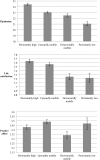Unequally distributed psychological assets: are there social disparities in optimism, life satisfaction, and positive affect?
- PMID: 25671665
- PMCID: PMC4324648
- DOI: 10.1371/journal.pone.0118066
Unequally distributed psychological assets: are there social disparities in optimism, life satisfaction, and positive affect?
Abstract
Socioeconomic status is associated with health disparities, but underlying psychosocial mechanisms have not been fully identified. Dispositional optimism may be a psychosocial process linking socioeconomic status with health. We hypothesized that lower optimism would be associated with greater social disadvantage and poorer social mobility. We also investigated whether life satisfaction and positive affect showed similar patterns. Participants from the Midlife in the United States study self-reported their optimism, satisfaction, positive affect, and socioeconomic status (gender, race/ethnicity, education, occupational class and prestige, income). Social disparities in optimism were evident. Optimistic individuals tended to be white and highly educated, had an educated parent, belonged to higher occupational classes with more prestige, and had higher incomes. Findings were generally similar for satisfaction, but not positive affect. Greater optimism and satisfaction were also associated with educational achievement across generations. Optimism and life satisfaction are consistently linked with socioeconomic advantage and may be one conduit by which social disparities influence health.
Conflict of interest statement
Figures

References
-
- Adler NE, Ostrove JM (1999) Socioeconomic status and health: what we know and what we don’t. Ann N Y Acad Sci 896: 3–15. - PubMed
-
- Gallo LC (2009) The Reserve Capacity Model as a framework for understanding psychosocial factors in health disparities. Applied Psychology: Health and Well-Being 1: 62–72.
-
- Gallo LC, Bogart LM, Vranceanu A-M, Matthews KA (2005) Socioeconomic status, resources, psychological experiences, and emotional responses: a test of the Reserve Capacity Model. J Pers Soc Psychol 88: 386–399. - PubMed
Publication types
MeSH terms
Grants and funding
LinkOut - more resources
Full Text Sources
Other Literature Sources

